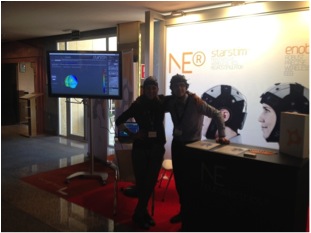As some of you know I am an entrepreneur leading a medical device company working on brain related technologies. Bust what most of you don´t know is that at personal level I also happen to have a very close relative, my aunt Vicky, who suffered from a cardiovascular accident that force her to stay in a wheelchair from one day to another at a young age.
I had the pleasure of attending the ICNR 2012 in Toledo, the International Conference on Neurorehabilitation in which researchers and clinicians around the globe got together to explain how progress have been made in restoring neuromotor abilities.
It was really impressive to learn the latest advances in the different fields in science involved in helping those that lost human motor and cognitive functions, from fields ranging from Brain Computer Interface, Neuromodulation to Biomechanics, Prostheses and Robotics.
It was really impressive to find out the latest work by some of the leading research groups in the field. The keynote speech performed by Prof. Grégoire Courtine at EPFL, Zurich, was impressive, the results of his research show a rat with spinal cord injury and sever paralysis, not only walking again, but running and adaptively climbing up some stairs. His approach was based on a combination of electrical-chemical stimulation and a robotic harness to allow voluntary movement.
The audience at the conference acknowledge the data provided by Prof. Courtine and how, for the first time, it opens a new approach into rehabilitation, proving that the plasticity of the spinal column can be adequately woken up even in severe cases.
This novel approach into neurorehabilitaion is a breakthrough pointing the way to future applications in the clinical field. If Courtine´s rats are now 100% recuperating voluntary movement, how can this be translated into humans? We will still have to wait some time, but it was really one of the very good findings of the conference.
I really invite you to see any of the videos in his official website or this TED talk.
Another very interesting work was presented by Prof. Jane Burridge, from the University of Southampton.
Apparently after suffering from a stroke, the ability to walk is more regained that the ability to move again arm and hand function. Conventional therapies appear to be not very effective, Dr. Burridge is combining robot motor theraphy with tDCS (transcranial direct current stimulation) for those severly impared hand after stroke as a way to increase the excitability of nerve pathways within the motor cortex.
There were many interesting talks, in different areas, another one I found really interesting is the combination of both, BCI (Brain Computer Interfaces) and Non-invasive Brain Stimulation (tDCS, transcranial direct current stimulation) for rehabilitation.
tDCS has been proved to increase/decrease Motor evoked potentials, consistently there is evidence that tDCS also modulates ERD tasks during Motor Imagery BCI.
The work presented by Ricardo Chavarriaga from EPFL showed how in healthy subjects there is not clear difference in BCI after sham or tDCS stimulation whilst in SCI (Spinal Cord Injured) subjects BCI performance was consistently more homogeneus between subjects and its minimum subject value larger after tDCS.
The conclusions of the study showed how the effect of the stimulation lasted for more than 90 minutes and that the anodal stimulation in motor areas may selectively enhance activity of targeted areas so as to produce patterns that can be better recognized in BCI.
There were many other relevant examples in many fields of how brave researchers and clinicians are working together to find answers and solutions to many challenges in neurorehabilitation.Every time I listen of the amazing advancements in the field I cannot but think of my aunt and how the future will be better if not for her, for many others that unfortunately will suffer from severe injuries.
Thanks to all the researchers and clinicians for dreaming that something can be done in the impossible situations, when movement seems to have vanished and restoration unviable, they have found new roots and demonstrated that even in the tougher situations there is room for hope. Keep up the good work and looking forward for the next ICNR!

